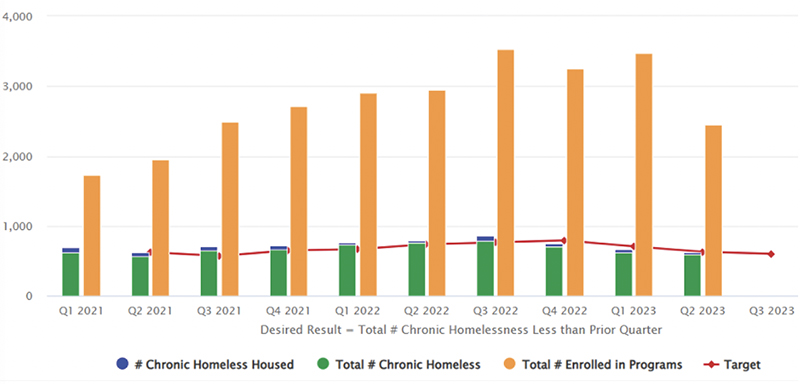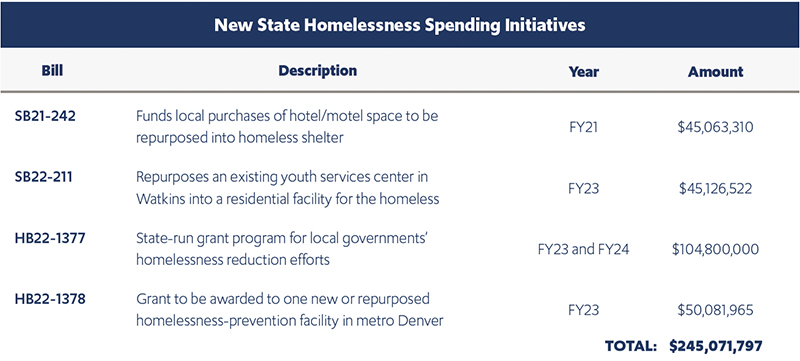2023 Local Elections and Homelessness
In 2023, Coloradans will have municipal elections in our most populated cities. To inform these debates CSI produced reports on the most pressing issues facing Colorado cities: crime, housing, and homelessness for Fort Collins, Denver, Grand Junction, Colorado Springs, and Aurora. This brief report features data and key insights on homelessness in Fort Collins and Larimer County.
The system of resources addressing homelessness is at a critical point. Though funding has increased significantly in recent years, much of the increase is from one-time federal, state, and municipal spending that will decline over the next few budget cycles. As spending on homelessness has increased annually, the unsheltered and chronically homeless populations have also increased. Housing affordability in Colorado has plummeted, overall price levels are at record highs due to inflation, and the state’s housing inventory is dangerously low. This is a concerning precursor for sustained elevated levels of newly homeless. Larimer County and Fort Collins, however, have been able to keep their unsheltered rates roughly consistent for nearly four years and have lower levels of chronic homelessness than other cities in Colorado, the majority of which have experienced drastic increases in the past few years. Fort Collins’ situation has not improved across the board, but the city seems to have mitigated some of the rapid increase in homelessness that other major cities have endured. The relative success that Fort Collins has achieved may be due to its uncommon transparency regarding its homelessness programs. The City is also planning the opening of a new mental health facility and 24/7 shelter, both of which demonstrate the city’s commitment to long-term solutions.
Key Findings
- The City of Fort Collins reports that, since the beginning of 2022, its programs have provided permanent housing to 577 (42%) of the 1,364 people who the city has identified as chronically homeless over those two years.
- Fort Collins currently spends $38,000–$95,000 per person annually on homelessness. This total includes costs incurred by emergency shelters, supportive services, crisis services, hospitals, emergency departments, and other services. The estimated yearly cost of a 1-bedroom apartment in Fort Collins is only $13,716–$25,716 per person.
- Between 2019 and 2023, the homeless population in Larimer County has grown 20% faster than the county’s total population.
Fort Collins Data Dashboard
The City of Fort Collins maintains a dashboard which tracks its quarterly goals to reduce the chronically homeless population by providing housing. It specifically measures the number of clients who are placed in permanent housing programs or who exit any local homelessness program to housed destinations. The city has failed to meet its targets across five of the previous nine quarters but succeeded in each of the last three and demonstrated some ability to recover from the COVID-19 era efficiently. The dashboard claims that the government of Fort Collins itself has a impact on the outcomes that it tracks due to the amount of resources that the city allocates to homelessness initiatives.
This year alone (2023), Fort Collins has housed 227 of its 757 chronically homeless individuals (30%), which is consistent with its trend over the last 2 years[i]. Records of Larimer County’s homeless population, however, demonstrate that the number of chronically homeless individuals has been steadily climbing since falling from its record high in 2019.

Population
The following table presents three estimates of the homeless population in Fort Collins: the point-in-time (PIT) count,[ii] which is a survey of the homeless population on a single night in January, the PIT count multiplied by 2.5, which is the Colorado Coalition for the Homeless’ estimate of the number of homeless across a full year, and an estimate of the number of people in Larimer County who accessed homelessness services during the year based upon Metro Denver Homeless Initiative’s count of such people in the Denver metro area. In the Northern Colorado Continuum of Care, which includes Fort Collins, PIT counts of unsheltered homeless are only conducted on odd-number years.

Larimer County’s homeless population has risen moderately over the last several years. Despite this, its homelessness problem is less severe than those of most other places along the Front Range—as a share of the county’s total population, Larimer County’s homeless population is lower than Denver’s, Grand Junction’s, Boulder’s, and El Paso County’s, and only marginally higher than Aurora’s. Of concern are Larimer’s unsheltered and chronically homeless populations, both of which grew significantly between 2018 and 2023. Although events associated with the COVID-19 pandemic appear to have only minimally affected the county’s rising homeless level, Larimer’s current unsheltered rate of over 30% and chronic homelessness level of nearly 30% are similar to those of cities when rates increased more dramatically during the pandemic.


State Budgeting and Local Policy
As homelessness has emerged as a growing problem in Colorado, including the Northern Colorado area, many municipalities appear to have dramatically increased their direct and indirect spending on homelessness resolution. Likewise, the state government has decided to undertake homelessness spending obligations that dwarf its usual ongoing contributions: through FY24, it plans to spend an additional $200 million on homelessness initiatives atop another $45 million that it already distributed in FY21.

Much of this and other new spending has been enabled by a windfall of federal funds—an exhaustible resource which governments cannot expect to persist long into the future. With this in mind, leaders in Fort Collins, a city facing moderate levels of unresolved homelessness, should strive to adopt practices conducive to the proper management of public resources, transparent recordkeeping, and efficacious policy. The upcoming local election presents the residents of Fort Collins an opportunity to steer policy in a beneficial direction and help their city continue to improve its trajectory. Evidence from Colorado Springs, whose unsheltered population has decreased by 27% since 2018, suggests that this can be achieved.
CSI’s 2022 report on homelessness spending in metro Denver finds that, though it’s possible to track most of the money spent on homelessness, understanding the actual supply of homelessness resources is much more difficult.iii Though Fort Collins, through the creation and promulgation of its performance dashboard, has made commendable progress towards this objective, more work could still be done. It’s particularly important that city policymakers develop frameworks for understanding what kinds of support (like shelter, medical care, mental health treatment, and skills training) are lacking, in excess, or in need of redeployment. Local and statewide efforts to increase public oversight of homelessness initiatives and resource allocation, likewise, can help communities find effective solutions.
About the Authors
Erik Gamm – Erik is a Research Analyst for Common Sense Institute
Chris Brown – Chris is the VP of Policy and Research for Common Sense Institute
Ethan Tartaglia – Ethan is a Research Analyst Intern for Common Sense Institute
Teams & Fellows Statement
CSI is committed to independent, in-depth research that examines the impacts of policies, initiatives, and proposed laws so that Coloradans and Arizonans are educated and informed on issues impacting their lives. CSI’s commitment to institutional independence is rooted in the individual independence of our researchers, economists, and fellows. At the core of CSI’s mission is a belief in the power of the free enterprise system. Our work explores ideas that protect and promote jobs and the economy, and the CSI team and fellows take part in this pursuit with academic freedom. Our team’s work is driven by data-driven research and evidence. The views and opinions of fellows do not reflect institutional views of CSI. CSI operates independently of any political party and does not take political positions.
[i] Homelessness Data, Chronic Homelessness, and # Chronic Homeless Housed
[ii] https://www.coloradocoalition.org/BoSCoCPITHIC
[iii] https://commonsenseinstituteco.org/homelessness-in-metro-denver/

